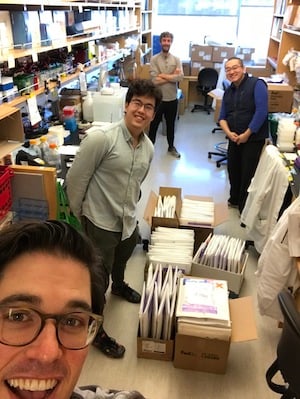This post was contributed by Manon Eckhardt and Melanie Brewer from the QBI Coronavirus Research Group at UCSF.
It’s been only a few months since we all became acutely aware of the threat of SARS-CoV-2. Like many in the science community, we’ve been motivated to do anything and everything we can to help find a cure -- and quickly. Normally drug discovery is a process that would take years and millions, if not billions, of dollars, but by approaching it from a new direction, we hope to do it much faster.
Years of science, done in weeks
 |
| Figure 1: Sending out 80 FedEx envelopes in a single day -- all while maintaining social distance. From front to back: David Gordon, Jeff Guo, Fengbo Zhou, Paddy O’Leary (UCSF). |
Our approach is to discover key human proteins that can be targeted (hopefully by existing therapeutics that are safe, effective, and already FDA-approved). This is a big job, but under the leadership of Nevan Krogan at UCSF we’ve brought together a network of scientists from more than 20 labs to form the QBI Coronavirus Research Group (QCRG) to do just this.
In under a month’s time, we’ve published an article on BioRxiv describing a comprehensive SARS-CoV-2 virus-human interaction network in which we expressed 26 of the 29 SARS-CoV-2 viral proteins in human cells and used these viral “bait” proteins to fish for human “prey” proteins that interact with the virus. As a result, we identified 332 human proteins that the virus interacts with in cells. Because viruses rely on the help of human proteins in their lifecycle, identifying these potential human helpers of SARS-CoV-2 (especially the ones that are druggable) is a key step in our strategy to throw a therapeutic monkeywrench into the virus’ hijacking of human cells. Even better, more than half the drugs hitting these proteins are FDA-approved or in clinical trials or preclinical studies already. We are following up on these leads as we speak, with collaborators in Paris and New York.
We want YOU to join the fight against coronavirus
We are just at the beginning of understanding how SARS-CoV-2 interacts with human proteins. For example, we used HEK293T cells in our first study, but we're planning to soon expand to other cell types, including more physiologically-relevant systems, to catch all the important interactions. It’s also important to determine if the human interactors we found in our map have an impact on virus replication. While we and our collaborators are starting these experiments, there's so much to do that we can use the whole science community's help. You could be the next scientist joining in this worldwide fight against SARS-CoV-2. As we’ve all been affected in various ways by the pandemic, it is clear that we have to stick together (6 feet apart), to fight the new Coronavirus.
To help get you started, here are a few key details. Our set of constructs comprises all SARS-CoV-2 viral proteins except for Nsp3 and Nsp16, and includes an additional catalytically dead version of the viral protease, Nsp5. Our set also includes a GFP construct as a control. For easier portability, all viral genes are flanked by EcoRI and BamHI restriction sites - so cloning projects should be fun and straight-forward. All constructs are tagged with a 2xStrep-tag for easy detection and affinity purification. All but one are in a pLVX vector background, so you can package them into lentiviral vectors if you need to. Additionally, they have an IRES-Puro marker to facilitate stable cell clone selection. Expression is driven by a fairly strong EF1alpha promoter. We have verified expression of correctly-sized proteins by Western Blot for 25 constructs, and confirmed expression via mass spec for two of the remaining viral proteins. Only Nsp11 ran bigger than expected, and Orf7b gave a lot of background in our study - so you might want to be careful with these clones (and help us figure out what is going on there!).
Find the Krogan Lab SARS-CoV-2 plasmids
(Note: The Nsp6 construct is undergoing QC and will be available shortly. Sign up for email alerts on the Krogan lab's Addgene page to get notified!)
Attacking coronavirus, one FedEx package at a time
Since the publication of our paper, our group has been inundated with requests to share our plasmids with other researchers. We have been excited to see so much interest, because it means more scientists will be working on this problem more quickly.
 |
| Figure 2: Getting our research in line, with a row of FedEx envelopes waiting to be shipped out of the Krogan lab at UCSF. |
Our team members (shout out to Margaret Soucheray, Jeff Guo, Paddy O’Leary, Fengbo Zhou, Helene Foussard, and Dave Gordon) have been quite busy shipping and sending plasmids to all who request them -- in locations all over the world, as far flung as the EU, Russia, India and Saudi Arabia -- as well as closer to home in the US and Canada. In fact, we received so many requests (175 and counting) that we ran out of FedEx supplies at one point and had to go begging for them from other labs at UCSF (the QCRG network coming to the rescue -- again!). Also, we’ve got to mention that our FedEx guy has been the best: Thanks, Todd!
As you can imagine, it’s also been quite the administrative headache receiving constant email requests and tracking their fulfillment manually in a shared spreadsheet and it takes time away from our research. For all these reasons, the QCRG is delighted to be partnering with Addgene, who will be taking over the distribution to expand the network of scientists working on this even more quickly.
And, if you’d like to keep up with what we are doing at QBI or the QCRG to continue our work toward a cure for COVID-19, be sure to follow us on Twitter (QBI_UCSF and KroganLab), Instagram, and Facebook.
Find more COVID-19 and coronavirus related plasmids and resources at Addgene*


Many thanks to our guest bloggers Manon Eckhardt (left) and Melanie Brewer (right) from the University of California, San Francisco.
Manon Eckhardt and Melanie Brewer are on the Science Communications Team at QBI UCSF. They are particularly interested in facilitating collaborative science, and making it accessible to all people, not just scientists!
*If you are requesting plasmids for coronavirus or COVID-19 research, please email Addgene at help@addgene.org with your order number and so it can be prioritized.
Topics: Other Plasmid Tools, Plasmids, COVID-19






Leave a Comment